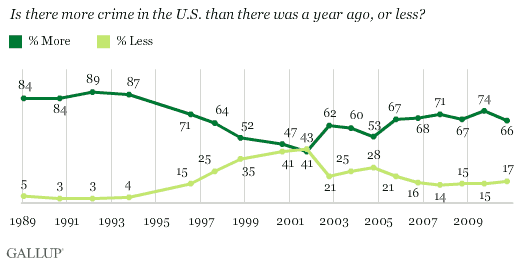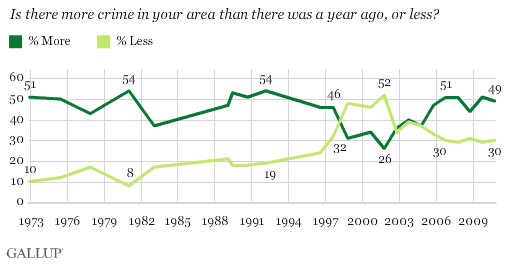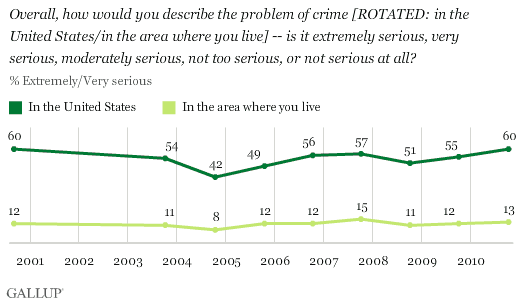PRINCETON, NJ -- Two-thirds of Americans say there is more crime in the United States than there was a year ago, reflecting Americans' general tendency to perceive crime as increasing. Still, the percentage perceiving an increase in crime is below what Gallup measured in the late 1980s and early 1990s, but is higher than the levels from the late 1990s and early 2000s.

Americans are somewhat more positive about the trend in crime in their local area, but still are more likely to see it going up than going down.

These trends, based on Gallup's annual Crime survey, come at a time when both the FBI and the Bureau of Justice Statistics recently reported drops in property and violent crime from 2008 to 2009 in separate studies, as well as documenting longer-term declines in both types of crime. Though the latest Gallup estimates, from an Oct. 7-10, 2010, survey, would reflect a more up-to-date assessment of the crime situation than those reports do, Americans were also likely to perceive crime as increasing both locally and nationally in the 2009 Gallup Crime survey.
The apparent contradiction in assessments of the crime situation stems from Americans' general tendency to view crime as increasing. That said, the percentage holding this view appears to be higher when crime actually is increasing, as in the late 1980s and early 1990s, than when it is not.
Americans' perceptions of crime may also be influenced by their general assessments of how things are going in the country. Americans generally believe the crime situation to be better when their satisfaction with national conditions is high, as in the late 1990s, when the economy was strong, and in the wake of the 9/11 terror attacks, when patriotism and support for political leaders surged. Thus, the current estimates of increasing crime may to some degree be inflated due to widespread dissatisfaction with the state of the U.S. today.
Apart from whether the crime rate is increasing, 60% of Americans believe the crime problem in the U.S. is "extremely" or "very serious," up from 55% in 2009 and tied for the highest Gallup has measured since 2000. A majority of Americans have typically rated the U.S. crime problem as extremely or very serious in the 11-year history of this question.
As is usually the case, Americans are much less concerned about the crime problem in their local area, as 13% say the crime problem is extremely or very serious where they live.

Americans who have been victimized by crime in the past 12 months are about twice as likely as those who have not been victimized to describe the crime problem in their local area as very serious (18% to 10%). Crime victims are also substantially more likely to perceive crime as increasing in their local area (62% to 43%). However, being a victim of crime bears little relationship to the way one perceives the crime situation in the U.S.
Results for this Gallup poll are based on telephone interviews conducted Oct. 7-10, 2010, with a random sample of 1,025 adults, aged 18 and older, living in the continental U.S., selected using random-digit-dial sampling.
For results based on the total sample of national adults, one can say with 95% confidence that the maximum margin of sampling error is ±4 percentage points.
Interviews are conducted with respondents on landline telephones (for respondents with a landline telephone) and cellular phones (for respondents who are cell phone-only). Each sample includes a minimum quota of 150 cell phone-only respondents and 850 landline respondents, with additional minimum quotas among landline respondents for gender within region. Landline respondents are chosen at random within each household on the basis of which member had the most recent birthday.
Samples are weighted by gender, age, race, education, region, and phone lines. Demographic weighting targets are based on the March 2009 Current Population Survey figures for the aged 18 and older non-institutionalized population living in continental U.S. telephone households. All reported margins of sampling error include the computed design effects for weighting and sample design.
In addition to sampling error, question wording and practical difficulties in conducting surveys can introduce error or bias into the findings of public opinion polls.
View methodology, full question results, and trend data.
For more details on Gallup's polling methodology, visit https://www.gallup.com/.
